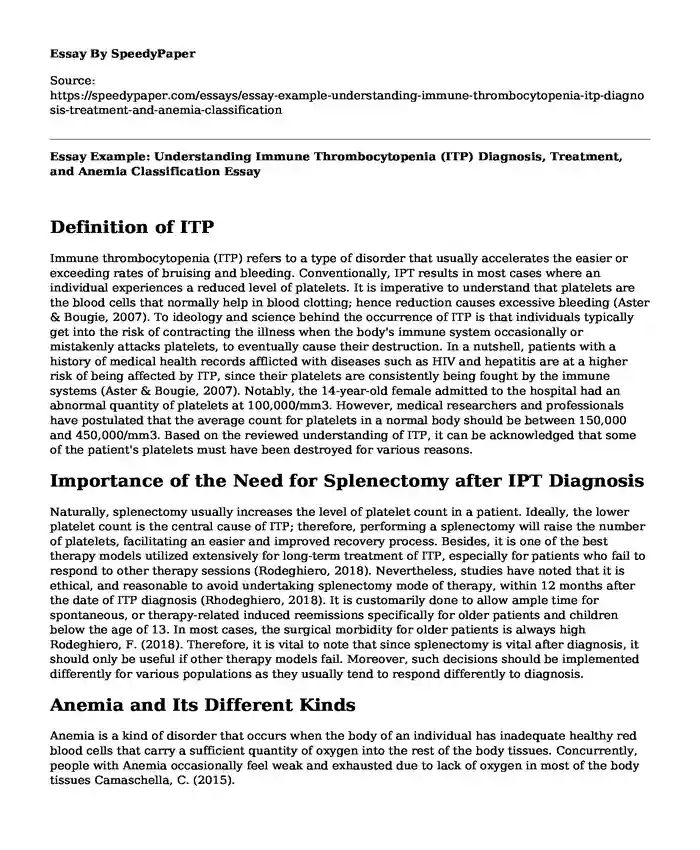Definition of ITP
Immune thrombocytopenia (ITP) refers to a type of disorder that usually accelerates the easier or exceeding rates of bruising and bleeding. Conventionally, IPT results in most cases where an individual experiences a reduced level of platelets. It is imperative to understand that platelets are the blood cells that normally help in blood clotting; hence reduction causes excessive bleeding (Aster & Bougie, 2007). To ideology and science behind the occurrence of ITP is that individuals typically get into the risk of contracting the illness when the body's immune system occasionally or mistakenly attacks platelets, to eventually cause their destruction. In a nutshell, patients with a history of medical health records afflicted with diseases such as HIV and hepatitis are at a higher risk of being affected by ITP, since their platelets are consistently being fought by the immune systems (Aster & Bougie, 2007). Notably, the 14-year-old female admitted to the hospital had an abnormal quantity of platelets at 100,000/mm3. However, medical researchers and professionals have postulated that the average count for platelets in a normal body should be between 150,000 and 450,000/mm3. Based on the reviewed understanding of ITP, it can be acknowledged that some of the patient's platelets must have been destroyed for various reasons.
Importance of the Need for Splenectomy after IPT Diagnosis
Naturally, splenectomy usually increases the level of platelet count in a patient. Ideally, the lower platelet count is the central cause of ITP; therefore, performing a splenectomy will raise the number of platelets, facilitating an easier and improved recovery process. Besides, it is one of the best therapy models utilized extensively for long-term treatment of ITP, especially for patients who fail to respond to other therapy sessions (Rodeghiero, 2018). Nevertheless, studies have noted that it is ethical, and reasonable to avoid undertaking splenectomy mode of therapy, within 12 months after the date of ITP diagnosis (Rhodeghiero, 2018). It is customarily done to allow ample time for spontaneous, or therapy-related induced reemissions specifically for older patients and children below the age of 13. In most cases, the surgical morbidity for older patients is always high Rodeghiero, F. (2018). Therefore, it is vital to note that since splenectomy is vital after diagnosis, it should only be useful if other therapy models fail. Moreover, such decisions should be implemented differently for various populations as they usually tend to respond differently to diagnosis.
Anemia and Its Different Kinds
Anemia is a kind of disorder that occurs when the body of an individual has inadequate healthy red blood cells that carry a sufficient quantity of oxygen into the rest of the body tissues. Concurrently, people with Anemia occasionally feel weak and exhausted due to lack of oxygen in most of the body tissues Camaschella, C. (2015).
Classification of different kinds of anemia must primarily be based on the volume of RBC that one has. There are two different kinds of anemia: macro and macrocytic. For macrocytic anemia, the level of available red blood cells usually exceeds the normal count of red blood cells that a human being should have. In contrast, macroanalemia occurs when one has fewer cells than what is required for normal body functioning. Studies done by Marignani et al. (1999) showed that macrocytic anemia could be caused by a lack of vitamin B12 and folate. Furthermore, its presence should help a medical attendant signal a possible underlying condition in that specific patient. Meanwhile, the macrocytic form of anemia can further be classified into megaloblastic and no megaloblastic kinds. Megaloblastic macrocytic anemia is caused when there is a dysfunction in the system of producing red blood cells, while non-megaloblastic kind is caused by various underlying conditions such as trauma, and chronic illness (Marignani et al., 1999).
References
Aster, R. H., & Bougie, D. W. (2007). Drug-induced immune thrombocytopenia. New England Journal of Medicine, 357(6), 580-587. https://www.nejm.org/doi/full/10.1056/NEJMra066469
Camaschella, C. (2015). Iron-deficiency anemia. New England Journal Of Medicine, 372(19), 1832-1843. https://www.nejm.org/doi/full/10.1056/NEJMra1401038
Marignani, M., Delle Fave, G., Mecarocci, S., Bordi, C., Angeletti, S., D'Ambra, G., ... & Annibale, B. (1999). High prevalence of atrophic body gastritis in patients with unexplained microcytic and macrocytic anemia: a prospective screening study. The American Journal Of Gastroenterology, 94(3), 766-772. https://www.sciencedirect.com/science/article/pii/S0002927099000040
Rodeghiero, F. (2018). A critical appraisal of the evidence for the role of splenectomy in adults and children with ITP. British Journal of Hematology, 181(2), 183-195. https://onlinelibrary.wiley.com/doi/abs/10.1111/bjh.15090
Cite this page
Essay Example: Understanding Immune Thrombocytopenia (ITP) Diagnosis, Treatment, and Anemia Classification. (2023, Nov 08). Retrieved from https://speedypaper.net/essays/essay-example-understanding-immune-thrombocytopenia-itp-diagnosis-treatment-and-anemia-classification
Request Removal
If you are the original author of this essay and no longer wish to have it published on the SpeedyPaper website, please click below to request its removal:
- Argumentative Essay Example on the Euthanasia Issue
- Essay Sample: Pharmacological Effects of Amiodarone in the Management of Arrhythmias and Nursing Implications
- Free Essay Containing a Case Study on Bipolar Disorder
- Paper Example. Scope of Practice for an APN
- Essay Sample on Patient Safety Concerns and Health IT
- Paper Example. Serotonin Norepinephrine Reuptake Inhibitors Drug
- Free Essay Example - Market Depression
Popular categories





